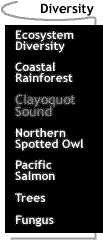

  |
Diversity: Clayoquot Sound The following paragraph describes Clayquot Sound, an area of old-growth forest on the western side of Vancouver Island. Several years ago Clayoquot Sound was the scene of confrontations between environmentalists and lumber company people, and the area remains a place of conflicting values and priorities.
You may want to browse through these images of Clayoquot Sound and read excerpts from a new book called Biodiversity in British Columbia: Our Changing Environment. [ Diversity: Ecosystem Diversity / Coastal Rainforest / [ Ecosystem Flexibility ] [ Natural & Human Disturbance ] [ Logging ] [ Home ] [ Teacher Pages ] [ Modules & Activities ] |
HTML code by Chris Kreger
Maintained by ETE Team
Last updated November 10, 2004
Some images © 2004 www.clipart.com
Privacy Statement and Copyright © 1997-2004 by Wheeling Jesuit University/NASA-supported Classroom of the Future. All rights reserved.
Center for Educational Technologies, Circuit Board/Apple graphic logo, and COTF Classroom of the Future logo are registered trademarks of Wheeling Jesuit University.